Business Law Assignment: Analysis of a Car Purchase Dispute Case
VerifiedAdded on 2020/06/05
|16
|5560
|337
Report
AI Summary
This report analyzes a business law case centered around a consumer, Mr. Ben, who purchased a second-hand car and encountered significant issues shortly after. The report delves into the relevant legal frameworks, primarily the Sale of Goods Act 1979, to assess the rights and obligations of both the buyer and the seller. It examines implied terms and conditions, statutory provisions concerning the transfer of property and possession, and the remedies available to buyers and sellers in the event of a breach of contract. Furthermore, the report explores product liability legal rules, consumer protection, and the implications of faulty goods. The case also touches upon credit agreements, particularly the Consumer Credit Act 1974, highlighting the financial aspects of the purchase. The report concludes with an analysis of the exclusion clause and its enforceability in this specific context, providing a comprehensive overview of the legal issues involved in the transaction.
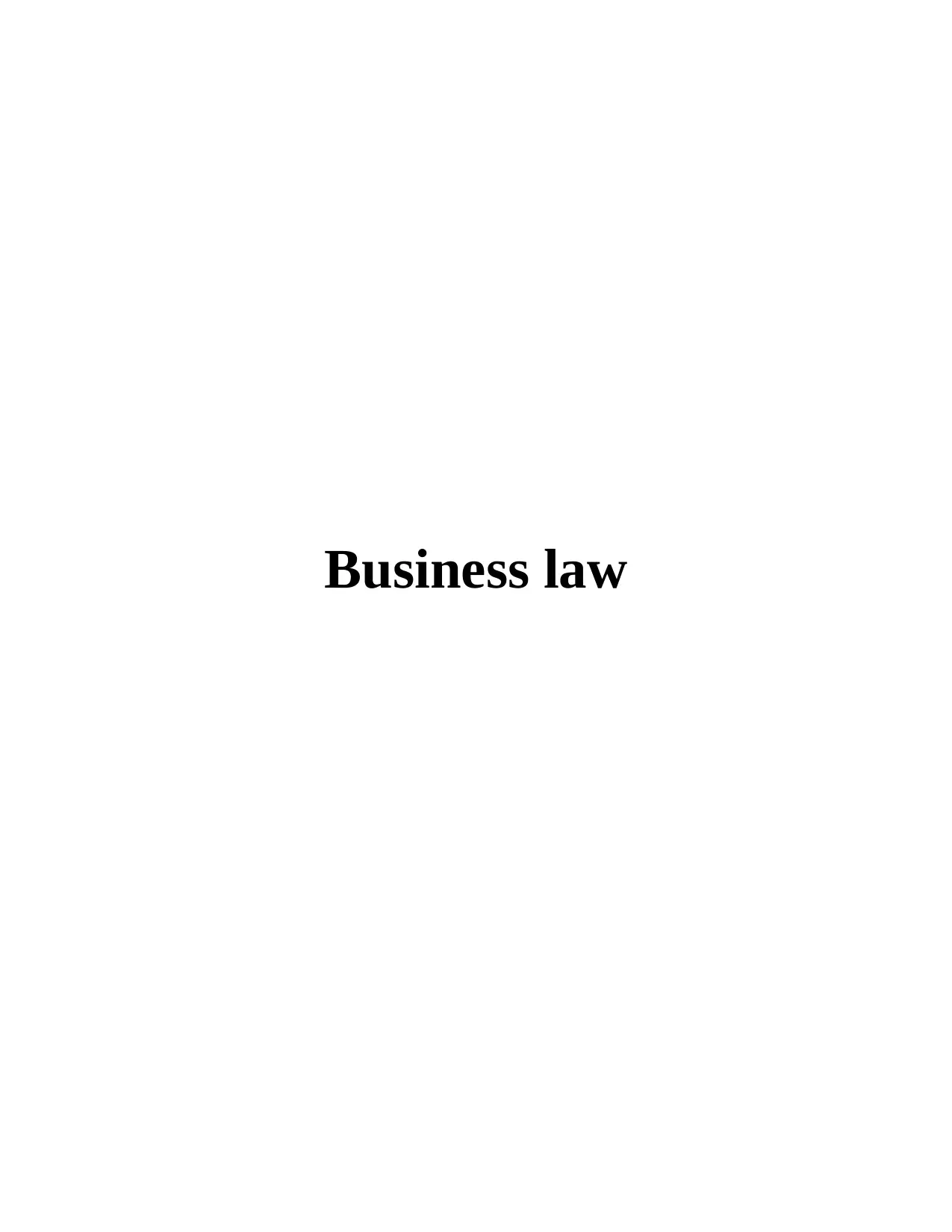
Business law
Paraphrase This Document
Need a fresh take? Get an instant paraphrase of this document with our AI Paraphraser
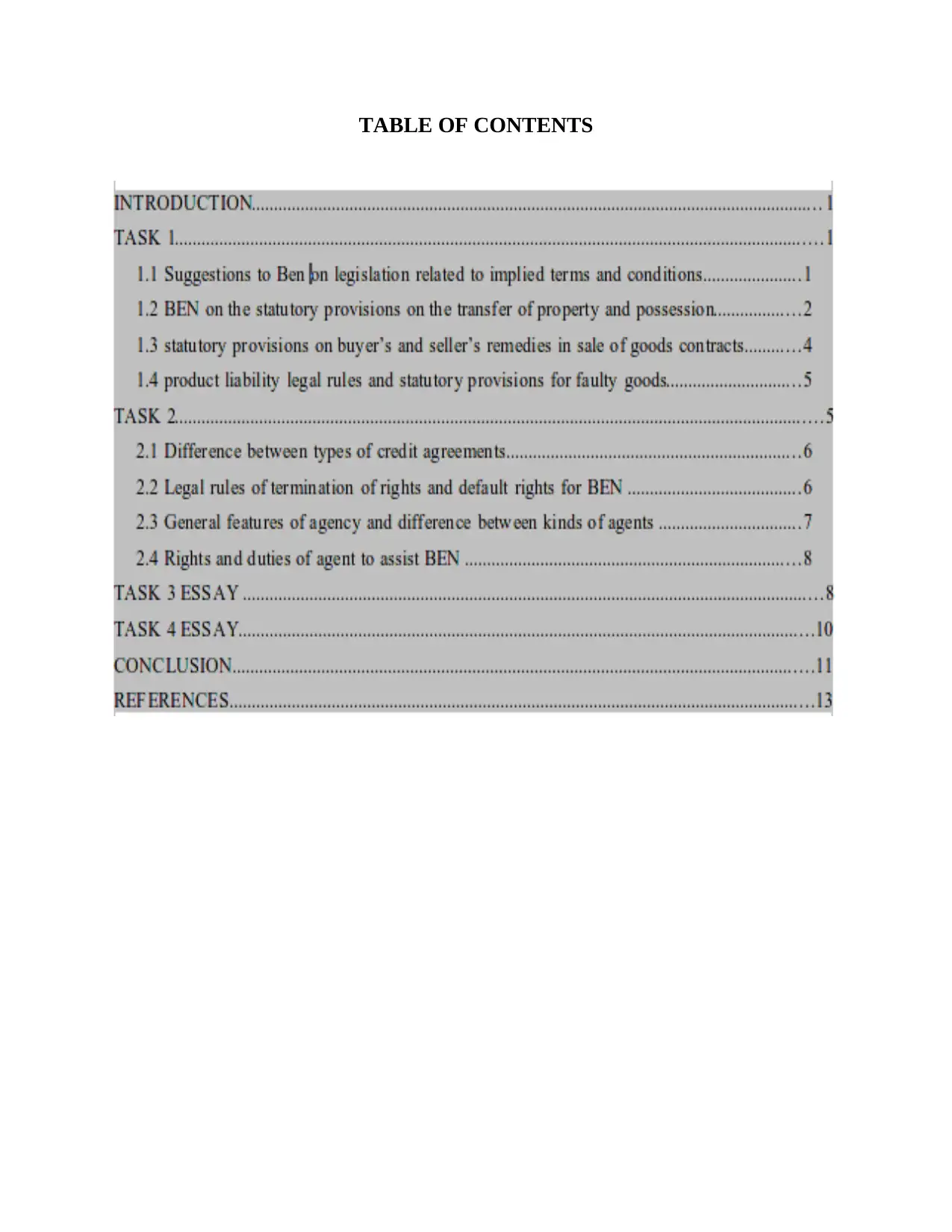
TABLE OF CONTENTS
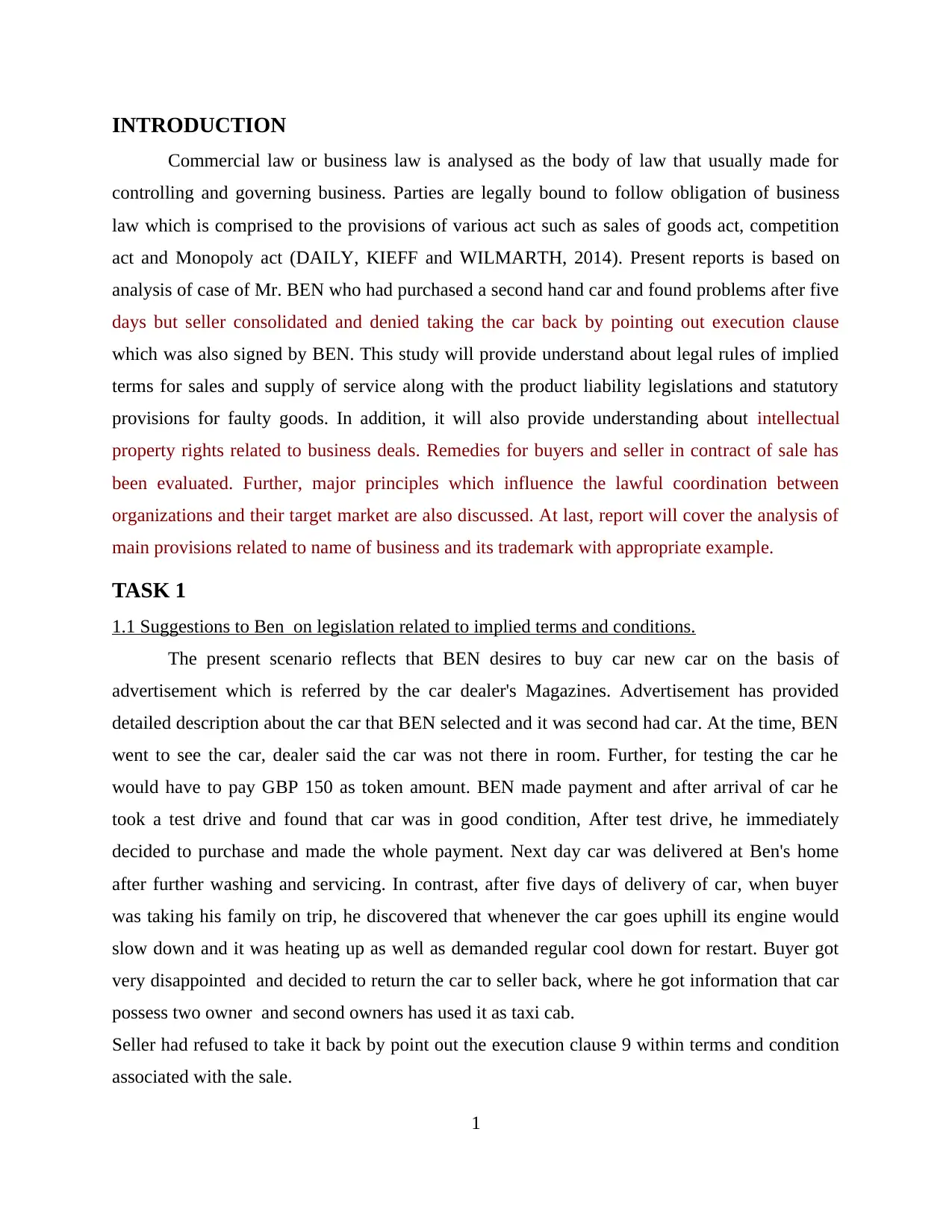
INTRODUCTION
Commercial law or business law is analysed as the body of law that usually made for
controlling and governing business. Parties are legally bound to follow obligation of business
law which is comprised to the provisions of various act such as sales of goods act, competition
act and Monopoly act (DAILY, KIEFF and WILMARTH, 2014). Present reports is based on
analysis of case of Mr. BEN who had purchased a second hand car and found problems after five
days but seller consolidated and denied taking the car back by pointing out execution clause
which was also signed by BEN. This study will provide understand about legal rules of implied
terms for sales and supply of service along with the product liability legislations and statutory
provisions for faulty goods. In addition, it will also provide understanding about intellectual
property rights related to business deals. Remedies for buyers and seller in contract of sale has
been evaluated. Further, major principles which influence the lawful coordination between
organizations and their target market are also discussed. At last, report will cover the analysis of
main provisions related to name of business and its trademark with appropriate example.
TASK 1
1.1 Suggestions to Ben on legislation related to implied terms and conditions.
The present scenario reflects that BEN desires to buy car new car on the basis of
advertisement which is referred by the car dealer's Magazines. Advertisement has provided
detailed description about the car that BEN selected and it was second had car. At the time, BEN
went to see the car, dealer said the car was not there in room. Further, for testing the car he
would have to pay GBP 150 as token amount. BEN made payment and after arrival of car he
took a test drive and found that car was in good condition, After test drive, he immediately
decided to purchase and made the whole payment. Next day car was delivered at Ben's home
after further washing and servicing. In contrast, after five days of delivery of car, when buyer
was taking his family on trip, he discovered that whenever the car goes uphill its engine would
slow down and it was heating up as well as demanded regular cool down for restart. Buyer got
very disappointed and decided to return the car to seller back, where he got information that car
possess two owner and second owners has used it as taxi cab.
Seller had refused to take it back by point out the execution clause 9 within terms and condition
associated with the sale.
1
Commercial law or business law is analysed as the body of law that usually made for
controlling and governing business. Parties are legally bound to follow obligation of business
law which is comprised to the provisions of various act such as sales of goods act, competition
act and Monopoly act (DAILY, KIEFF and WILMARTH, 2014). Present reports is based on
analysis of case of Mr. BEN who had purchased a second hand car and found problems after five
days but seller consolidated and denied taking the car back by pointing out execution clause
which was also signed by BEN. This study will provide understand about legal rules of implied
terms for sales and supply of service along with the product liability legislations and statutory
provisions for faulty goods. In addition, it will also provide understanding about intellectual
property rights related to business deals. Remedies for buyers and seller in contract of sale has
been evaluated. Further, major principles which influence the lawful coordination between
organizations and their target market are also discussed. At last, report will cover the analysis of
main provisions related to name of business and its trademark with appropriate example.
TASK 1
1.1 Suggestions to Ben on legislation related to implied terms and conditions.
The present scenario reflects that BEN desires to buy car new car on the basis of
advertisement which is referred by the car dealer's Magazines. Advertisement has provided
detailed description about the car that BEN selected and it was second had car. At the time, BEN
went to see the car, dealer said the car was not there in room. Further, for testing the car he
would have to pay GBP 150 as token amount. BEN made payment and after arrival of car he
took a test drive and found that car was in good condition, After test drive, he immediately
decided to purchase and made the whole payment. Next day car was delivered at Ben's home
after further washing and servicing. In contrast, after five days of delivery of car, when buyer
was taking his family on trip, he discovered that whenever the car goes uphill its engine would
slow down and it was heating up as well as demanded regular cool down for restart. Buyer got
very disappointed and decided to return the car to seller back, where he got information that car
possess two owner and second owners has used it as taxi cab.
Seller had refused to take it back by point out the execution clause 9 within terms and condition
associated with the sale.
1
⊘ This is a preview!⊘
Do you want full access?
Subscribe today to unlock all pages.

Trusted by 1+ million students worldwide
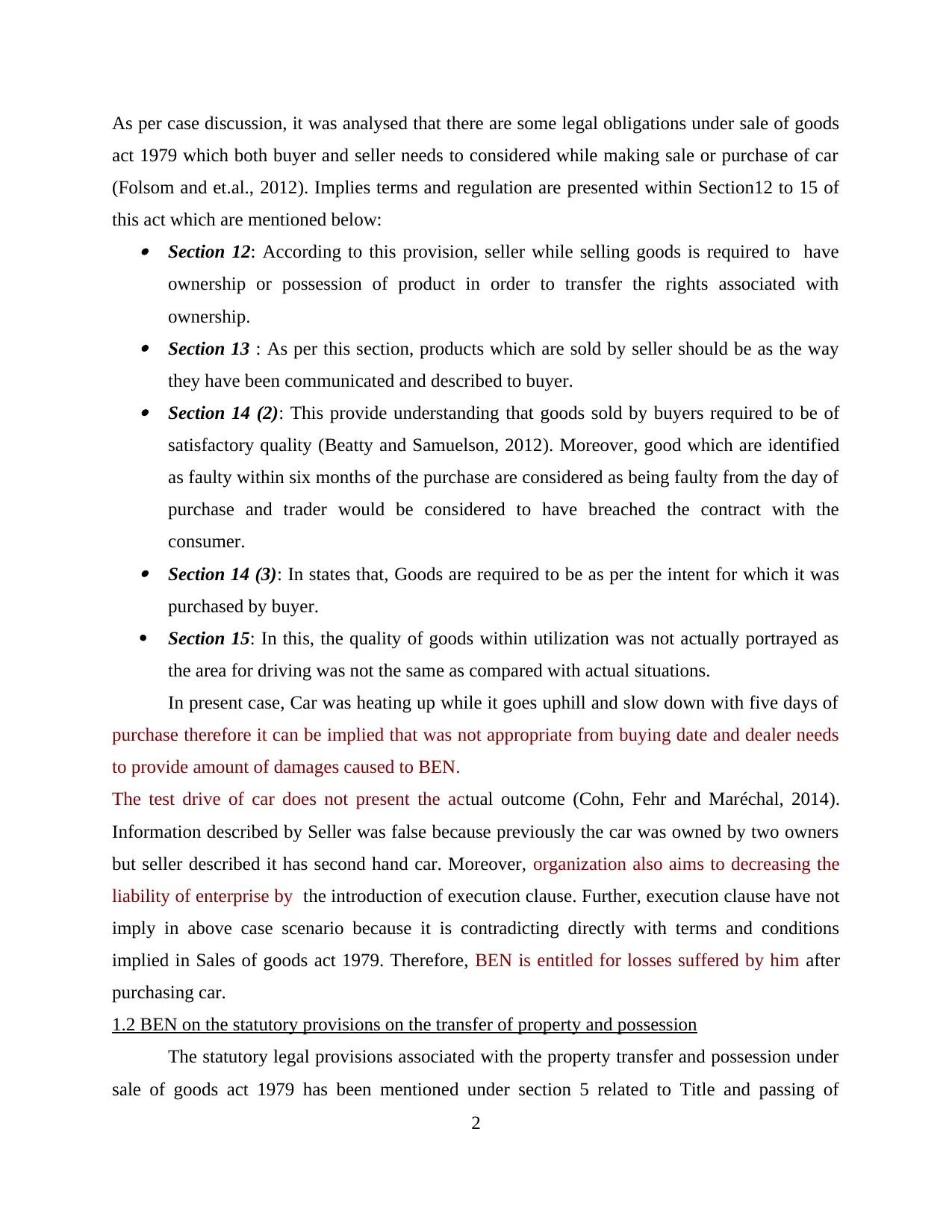
As per case discussion, it was analysed that there are some legal obligations under sale of goods
act 1979 which both buyer and seller needs to considered while making sale or purchase of car
(Folsom and et.al., 2012). Implies terms and regulation are presented within Section12 to 15 of
this act which are mentioned below: Section 12: According to this provision, seller while selling goods is required to have
ownership or possession of product in order to transfer the rights associated with
ownership. Section 13 : As per this section, products which are sold by seller should be as the way
they have been communicated and described to buyer. Section 14 (2): This provide understanding that goods sold by buyers required to be of
satisfactory quality (Beatty and Samuelson, 2012). Moreover, good which are identified
as faulty within six months of the purchase are considered as being faulty from the day of
purchase and trader would be considered to have breached the contract with the
consumer. Section 14 (3): In states that, Goods are required to be as per the intent for which it was
purchased by buyer.
Section 15: In this, the quality of goods within utilization was not actually portrayed as
the area for driving was not the same as compared with actual situations.
In present case, Car was heating up while it goes uphill and slow down with five days of
purchase therefore it can be implied that was not appropriate from buying date and dealer needs
to provide amount of damages caused to BEN.
The test drive of car does not present the actual outcome (Cohn, Fehr and Maréchal, 2014).
Information described by Seller was false because previously the car was owned by two owners
but seller described it has second hand car. Moreover, organization also aims to decreasing the
liability of enterprise by the introduction of execution clause. Further, execution clause have not
imply in above case scenario because it is contradicting directly with terms and conditions
implied in Sales of goods act 1979. Therefore, BEN is entitled for losses suffered by him after
purchasing car.
1.2 BEN on the statutory provisions on the transfer of property and possession
The statutory legal provisions associated with the property transfer and possession under
sale of goods act 1979 has been mentioned under section 5 related to Title and passing of
2
act 1979 which both buyer and seller needs to considered while making sale or purchase of car
(Folsom and et.al., 2012). Implies terms and regulation are presented within Section12 to 15 of
this act which are mentioned below: Section 12: According to this provision, seller while selling goods is required to have
ownership or possession of product in order to transfer the rights associated with
ownership. Section 13 : As per this section, products which are sold by seller should be as the way
they have been communicated and described to buyer. Section 14 (2): This provide understanding that goods sold by buyers required to be of
satisfactory quality (Beatty and Samuelson, 2012). Moreover, good which are identified
as faulty within six months of the purchase are considered as being faulty from the day of
purchase and trader would be considered to have breached the contract with the
consumer. Section 14 (3): In states that, Goods are required to be as per the intent for which it was
purchased by buyer.
Section 15: In this, the quality of goods within utilization was not actually portrayed as
the area for driving was not the same as compared with actual situations.
In present case, Car was heating up while it goes uphill and slow down with five days of
purchase therefore it can be implied that was not appropriate from buying date and dealer needs
to provide amount of damages caused to BEN.
The test drive of car does not present the actual outcome (Cohn, Fehr and Maréchal, 2014).
Information described by Seller was false because previously the car was owned by two owners
but seller described it has second hand car. Moreover, organization also aims to decreasing the
liability of enterprise by the introduction of execution clause. Further, execution clause have not
imply in above case scenario because it is contradicting directly with terms and conditions
implied in Sales of goods act 1979. Therefore, BEN is entitled for losses suffered by him after
purchasing car.
1.2 BEN on the statutory provisions on the transfer of property and possession
The statutory legal provisions associated with the property transfer and possession under
sale of goods act 1979 has been mentioned under section 5 related to Title and passing of
2
Paraphrase This Document
Need a fresh take? Get an instant paraphrase of this document with our AI Paraphraser
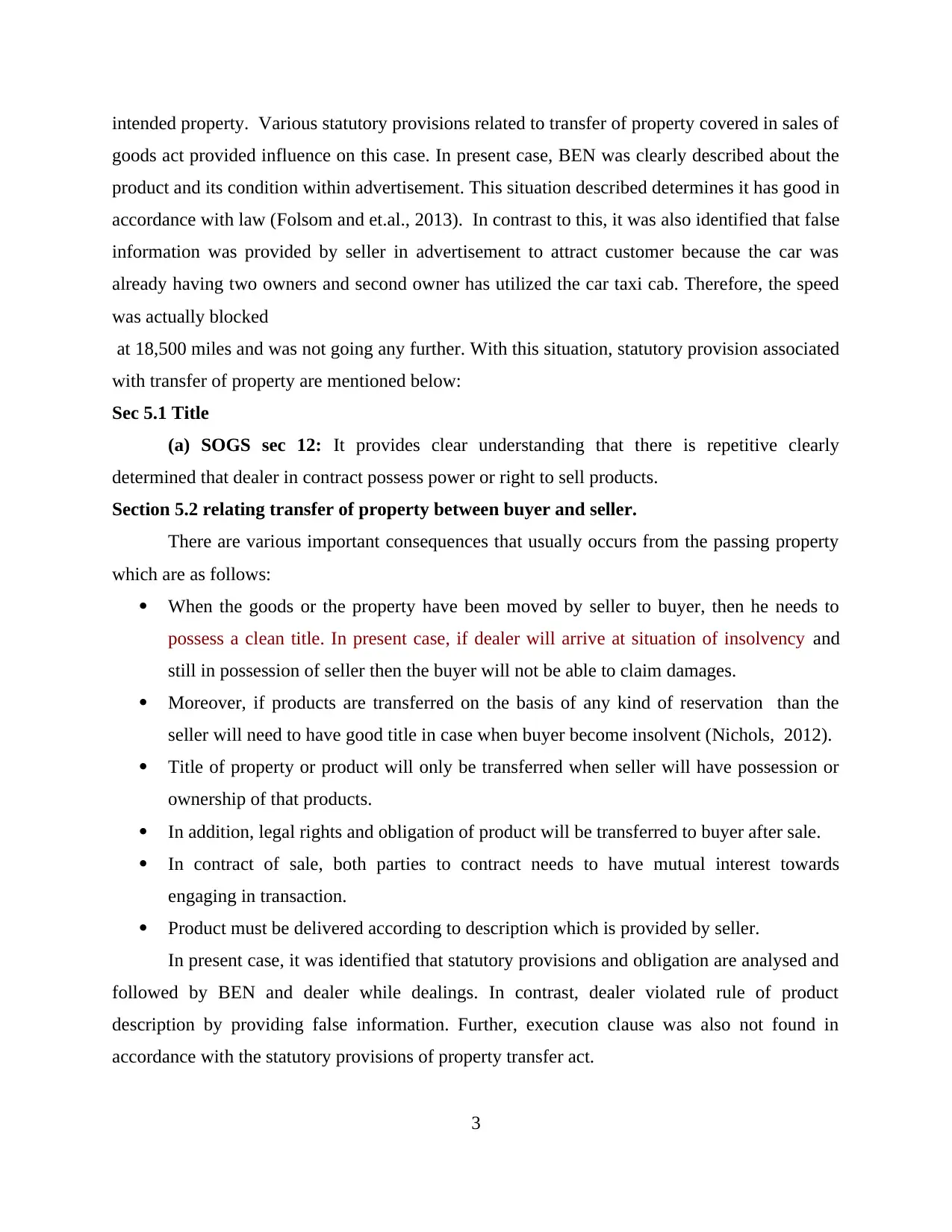
intended property. Various statutory provisions related to transfer of property covered in sales of
goods act provided influence on this case. In present case, BEN was clearly described about the
product and its condition within advertisement. This situation described determines it has good in
accordance with law (Folsom and et.al., 2013). In contrast to this, it was also identified that false
information was provided by seller in advertisement to attract customer because the car was
already having two owners and second owner has utilized the car taxi cab. Therefore, the speed
was actually blocked
at 18,500 miles and was not going any further. With this situation, statutory provision associated
with transfer of property are mentioned below:
Sec 5.1 Title
(a) SOGS sec 12: It provides clear understanding that there is repetitive clearly
determined that dealer in contract possess power or right to sell products.
Section 5.2 relating transfer of property between buyer and seller.
There are various important consequences that usually occurs from the passing property
which are as follows:
When the goods or the property have been moved by seller to buyer, then he needs to
possess a clean title. In present case, if dealer will arrive at situation of insolvency and
still in possession of seller then the buyer will not be able to claim damages.
Moreover, if products are transferred on the basis of any kind of reservation than the
seller will need to have good title in case when buyer become insolvent (Nichols, 2012).
Title of property or product will only be transferred when seller will have possession or
ownership of that products.
In addition, legal rights and obligation of product will be transferred to buyer after sale.
In contract of sale, both parties to contract needs to have mutual interest towards
engaging in transaction.
Product must be delivered according to description which is provided by seller.
In present case, it was identified that statutory provisions and obligation are analysed and
followed by BEN and dealer while dealings. In contrast, dealer violated rule of product
description by providing false information. Further, execution clause was also not found in
accordance with the statutory provisions of property transfer act.
3
goods act provided influence on this case. In present case, BEN was clearly described about the
product and its condition within advertisement. This situation described determines it has good in
accordance with law (Folsom and et.al., 2013). In contrast to this, it was also identified that false
information was provided by seller in advertisement to attract customer because the car was
already having two owners and second owner has utilized the car taxi cab. Therefore, the speed
was actually blocked
at 18,500 miles and was not going any further. With this situation, statutory provision associated
with transfer of property are mentioned below:
Sec 5.1 Title
(a) SOGS sec 12: It provides clear understanding that there is repetitive clearly
determined that dealer in contract possess power or right to sell products.
Section 5.2 relating transfer of property between buyer and seller.
There are various important consequences that usually occurs from the passing property
which are as follows:
When the goods or the property have been moved by seller to buyer, then he needs to
possess a clean title. In present case, if dealer will arrive at situation of insolvency and
still in possession of seller then the buyer will not be able to claim damages.
Moreover, if products are transferred on the basis of any kind of reservation than the
seller will need to have good title in case when buyer become insolvent (Nichols, 2012).
Title of property or product will only be transferred when seller will have possession or
ownership of that products.
In addition, legal rights and obligation of product will be transferred to buyer after sale.
In contract of sale, both parties to contract needs to have mutual interest towards
engaging in transaction.
Product must be delivered according to description which is provided by seller.
In present case, it was identified that statutory provisions and obligation are analysed and
followed by BEN and dealer while dealings. In contrast, dealer violated rule of product
description by providing false information. Further, execution clause was also not found in
accordance with the statutory provisions of property transfer act.
3
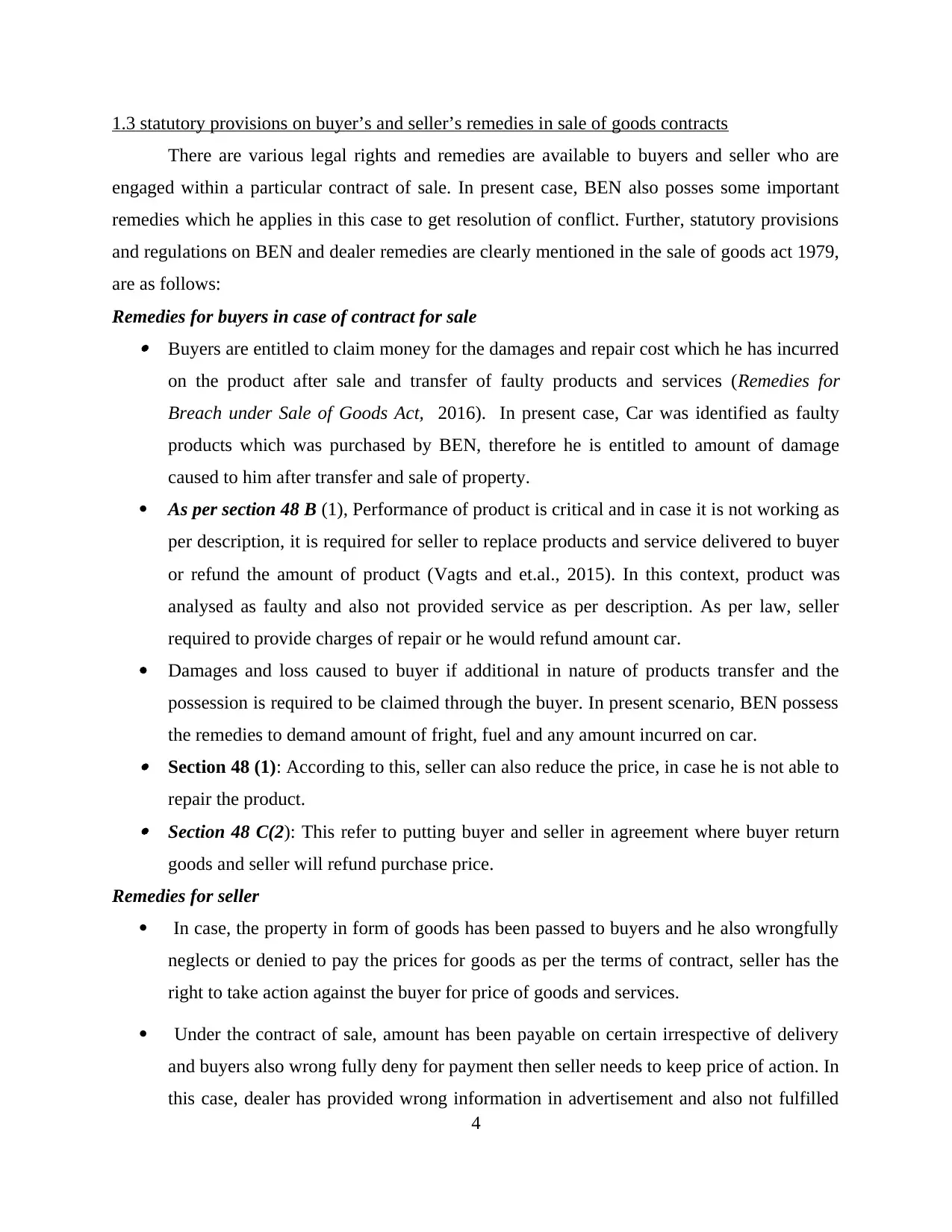
1.3 statutory provisions on buyer’s and seller’s remedies in sale of goods contracts
There are various legal rights and remedies are available to buyers and seller who are
engaged within a particular contract of sale. In present case, BEN also posses some important
remedies which he applies in this case to get resolution of conflict. Further, statutory provisions
and regulations on BEN and dealer remedies are clearly mentioned in the sale of goods act 1979,
are as follows:
Remedies for buyers in case of contract for sale Buyers are entitled to claim money for the damages and repair cost which he has incurred
on the product after sale and transfer of faulty products and services (Remedies for
Breach under Sale of Goods Act, 2016). In present case, Car was identified as faulty
products which was purchased by BEN, therefore he is entitled to amount of damage
caused to him after transfer and sale of property.
As per section 48 B (1), Performance of product is critical and in case it is not working as
per description, it is required for seller to replace products and service delivered to buyer
or refund the amount of product (Vagts and et.al., 2015). In this context, product was
analysed as faulty and also not provided service as per description. As per law, seller
required to provide charges of repair or he would refund amount car.
Damages and loss caused to buyer if additional in nature of products transfer and the
possession is required to be claimed through the buyer. In present scenario, BEN possess
the remedies to demand amount of fright, fuel and any amount incurred on car. Section 48 (1): According to this, seller can also reduce the price, in case he is not able to
repair the product. Section 48 C(2): This refer to putting buyer and seller in agreement where buyer return
goods and seller will refund purchase price.
Remedies for seller
In case, the property in form of goods has been passed to buyers and he also wrongfully
neglects or denied to pay the prices for goods as per the terms of contract, seller has the
right to take action against the buyer for price of goods and services.
Under the contract of sale, amount has been payable on certain irrespective of delivery
and buyers also wrong fully deny for payment then seller needs to keep price of action. In
this case, dealer has provided wrong information in advertisement and also not fulfilled
4
There are various legal rights and remedies are available to buyers and seller who are
engaged within a particular contract of sale. In present case, BEN also posses some important
remedies which he applies in this case to get resolution of conflict. Further, statutory provisions
and regulations on BEN and dealer remedies are clearly mentioned in the sale of goods act 1979,
are as follows:
Remedies for buyers in case of contract for sale Buyers are entitled to claim money for the damages and repair cost which he has incurred
on the product after sale and transfer of faulty products and services (Remedies for
Breach under Sale of Goods Act, 2016). In present case, Car was identified as faulty
products which was purchased by BEN, therefore he is entitled to amount of damage
caused to him after transfer and sale of property.
As per section 48 B (1), Performance of product is critical and in case it is not working as
per description, it is required for seller to replace products and service delivered to buyer
or refund the amount of product (Vagts and et.al., 2015). In this context, product was
analysed as faulty and also not provided service as per description. As per law, seller
required to provide charges of repair or he would refund amount car.
Damages and loss caused to buyer if additional in nature of products transfer and the
possession is required to be claimed through the buyer. In present scenario, BEN possess
the remedies to demand amount of fright, fuel and any amount incurred on car. Section 48 (1): According to this, seller can also reduce the price, in case he is not able to
repair the product. Section 48 C(2): This refer to putting buyer and seller in agreement where buyer return
goods and seller will refund purchase price.
Remedies for seller
In case, the property in form of goods has been passed to buyers and he also wrongfully
neglects or denied to pay the prices for goods as per the terms of contract, seller has the
right to take action against the buyer for price of goods and services.
Under the contract of sale, amount has been payable on certain irrespective of delivery
and buyers also wrong fully deny for payment then seller needs to keep price of action. In
this case, dealer has provided wrong information in advertisement and also not fulfilled
4
⊘ This is a preview!⊘
Do you want full access?
Subscribe today to unlock all pages.

Trusted by 1+ million students worldwide
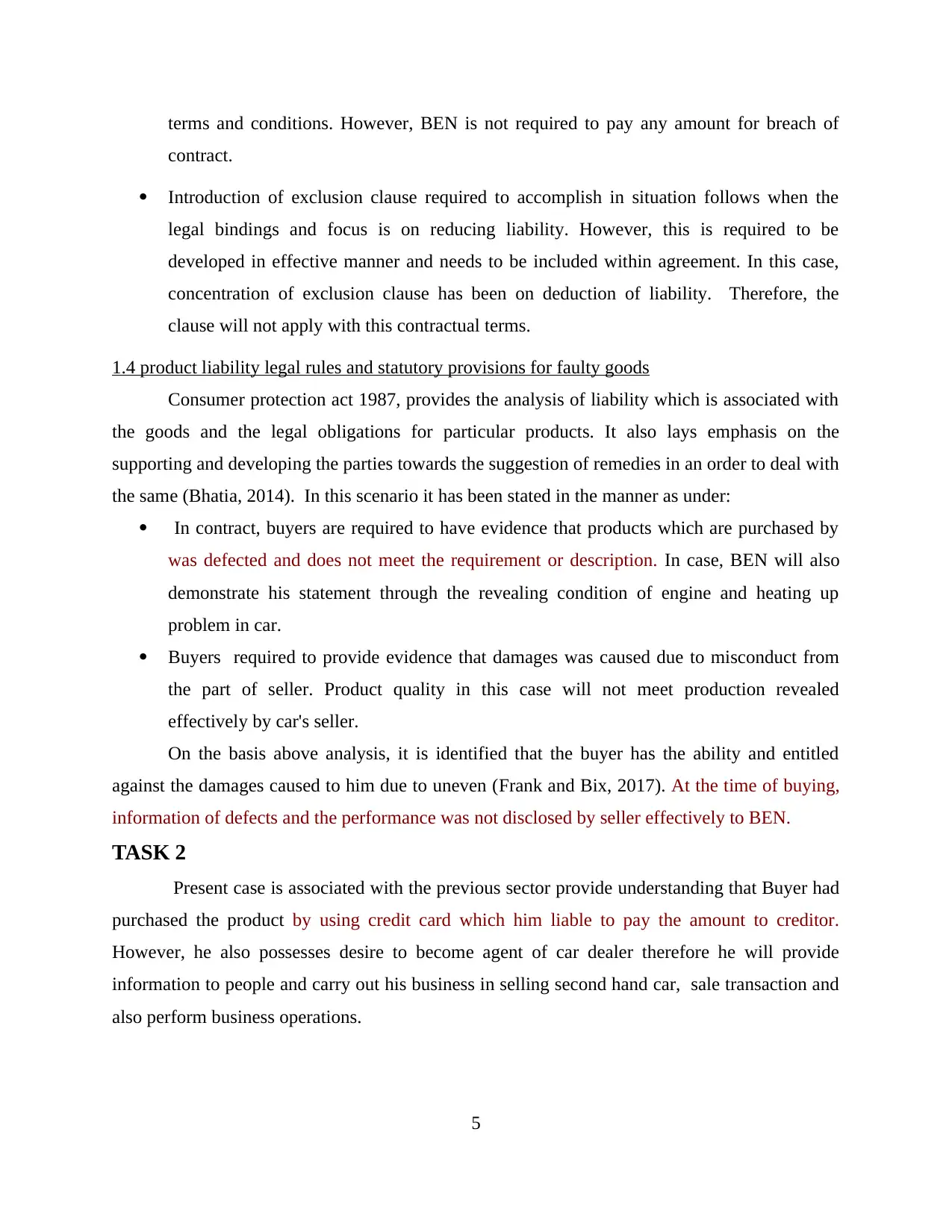
terms and conditions. However, BEN is not required to pay any amount for breach of
contract.
Introduction of exclusion clause required to accomplish in situation follows when the
legal bindings and focus is on reducing liability. However, this is required to be
developed in effective manner and needs to be included within agreement. In this case,
concentration of exclusion clause has been on deduction of liability. Therefore, the
clause will not apply with this contractual terms.
1.4 product liability legal rules and statutory provisions for faulty goods
Consumer protection act 1987, provides the analysis of liability which is associated with
the goods and the legal obligations for particular products. It also lays emphasis on the
supporting and developing the parties towards the suggestion of remedies in an order to deal with
the same (Bhatia, 2014). In this scenario it has been stated in the manner as under:
In contract, buyers are required to have evidence that products which are purchased by
was defected and does not meet the requirement or description. In case, BEN will also
demonstrate his statement through the revealing condition of engine and heating up
problem in car.
Buyers required to provide evidence that damages was caused due to misconduct from
the part of seller. Product quality in this case will not meet production revealed
effectively by car's seller.
On the basis above analysis, it is identified that the buyer has the ability and entitled
against the damages caused to him due to uneven (Frank and Bix, 2017). At the time of buying,
information of defects and the performance was not disclosed by seller effectively to BEN.
TASK 2
Present case is associated with the previous sector provide understanding that Buyer had
purchased the product by using credit card which him liable to pay the amount to creditor.
However, he also possesses desire to become agent of car dealer therefore he will provide
information to people and carry out his business in selling second hand car, sale transaction and
also perform business operations.
5
contract.
Introduction of exclusion clause required to accomplish in situation follows when the
legal bindings and focus is on reducing liability. However, this is required to be
developed in effective manner and needs to be included within agreement. In this case,
concentration of exclusion clause has been on deduction of liability. Therefore, the
clause will not apply with this contractual terms.
1.4 product liability legal rules and statutory provisions for faulty goods
Consumer protection act 1987, provides the analysis of liability which is associated with
the goods and the legal obligations for particular products. It also lays emphasis on the
supporting and developing the parties towards the suggestion of remedies in an order to deal with
the same (Bhatia, 2014). In this scenario it has been stated in the manner as under:
In contract, buyers are required to have evidence that products which are purchased by
was defected and does not meet the requirement or description. In case, BEN will also
demonstrate his statement through the revealing condition of engine and heating up
problem in car.
Buyers required to provide evidence that damages was caused due to misconduct from
the part of seller. Product quality in this case will not meet production revealed
effectively by car's seller.
On the basis above analysis, it is identified that the buyer has the ability and entitled
against the damages caused to him due to uneven (Frank and Bix, 2017). At the time of buying,
information of defects and the performance was not disclosed by seller effectively to BEN.
TASK 2
Present case is associated with the previous sector provide understanding that Buyer had
purchased the product by using credit card which him liable to pay the amount to creditor.
However, he also possesses desire to become agent of car dealer therefore he will provide
information to people and carry out his business in selling second hand car, sale transaction and
also perform business operations.
5
Paraphrase This Document
Need a fresh take? Get an instant paraphrase of this document with our AI Paraphraser
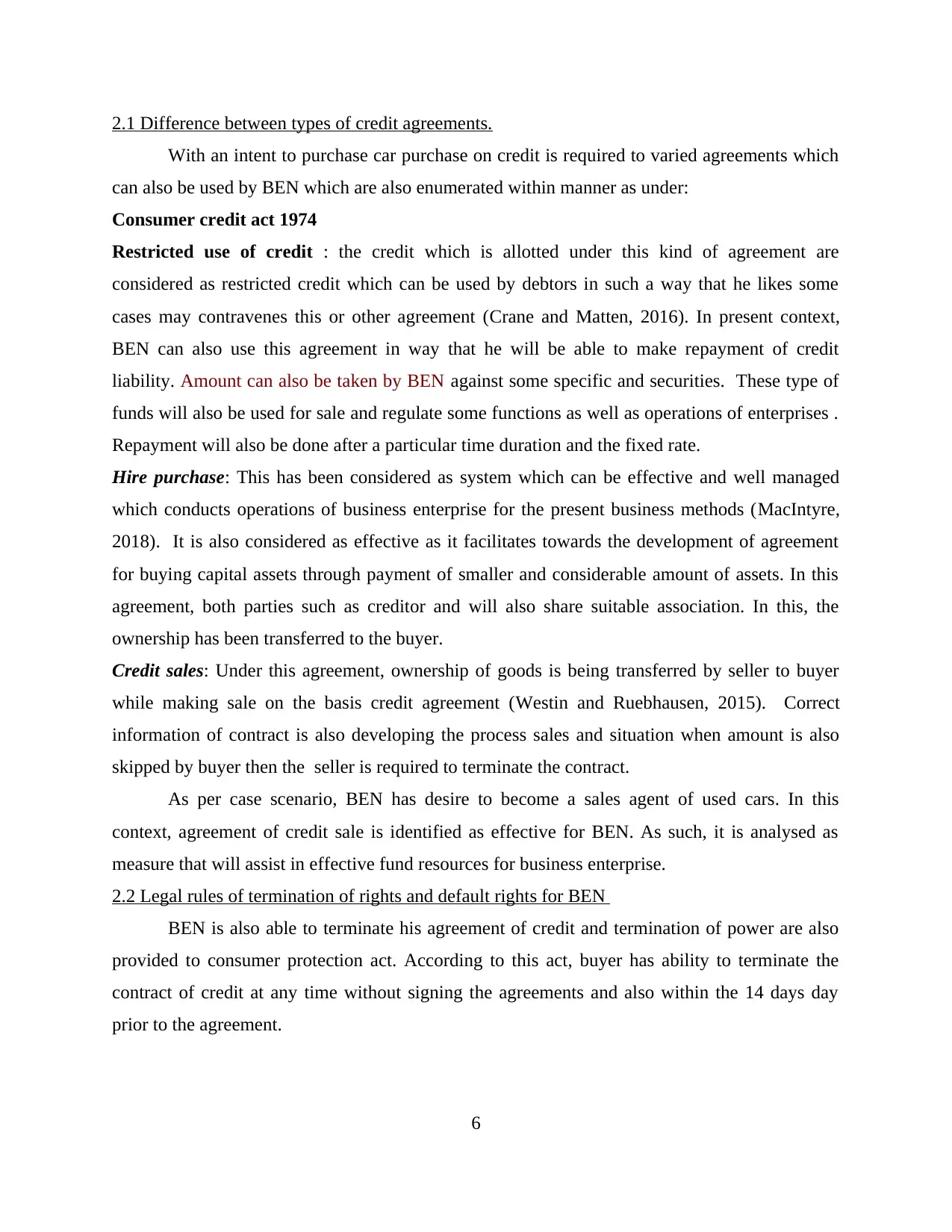
2.1 Difference between types of credit agreements.
With an intent to purchase car purchase on credit is required to varied agreements which
can also be used by BEN which are also enumerated within manner as under:
Consumer credit act 1974
Restricted use of credit : the credit which is allotted under this kind of agreement are
considered as restricted credit which can be used by debtors in such a way that he likes some
cases may contravenes this or other agreement (Crane and Matten, 2016). In present context,
BEN can also use this agreement in way that he will be able to make repayment of credit
liability. Amount can also be taken by BEN against some specific and securities. These type of
funds will also be used for sale and regulate some functions as well as operations of enterprises .
Repayment will also be done after a particular time duration and the fixed rate.
Hire purchase: This has been considered as system which can be effective and well managed
which conducts operations of business enterprise for the present business methods (MacIntyre,
2018). It is also considered as effective as it facilitates towards the development of agreement
for buying capital assets through payment of smaller and considerable amount of assets. In this
agreement, both parties such as creditor and will also share suitable association. In this, the
ownership has been transferred to the buyer.
Credit sales: Under this agreement, ownership of goods is being transferred by seller to buyer
while making sale on the basis credit agreement (Westin and Ruebhausen, 2015). Correct
information of contract is also developing the process sales and situation when amount is also
skipped by buyer then the seller is required to terminate the contract.
As per case scenario, BEN has desire to become a sales agent of used cars. In this
context, agreement of credit sale is identified as effective for BEN. As such, it is analysed as
measure that will assist in effective fund resources for business enterprise.
2.2 Legal rules of termination of rights and default rights for BEN
BEN is also able to terminate his agreement of credit and termination of power are also
provided to consumer protection act. According to this act, buyer has ability to terminate the
contract of credit at any time without signing the agreements and also within the 14 days day
prior to the agreement.
6
With an intent to purchase car purchase on credit is required to varied agreements which
can also be used by BEN which are also enumerated within manner as under:
Consumer credit act 1974
Restricted use of credit : the credit which is allotted under this kind of agreement are
considered as restricted credit which can be used by debtors in such a way that he likes some
cases may contravenes this or other agreement (Crane and Matten, 2016). In present context,
BEN can also use this agreement in way that he will be able to make repayment of credit
liability. Amount can also be taken by BEN against some specific and securities. These type of
funds will also be used for sale and regulate some functions as well as operations of enterprises .
Repayment will also be done after a particular time duration and the fixed rate.
Hire purchase: This has been considered as system which can be effective and well managed
which conducts operations of business enterprise for the present business methods (MacIntyre,
2018). It is also considered as effective as it facilitates towards the development of agreement
for buying capital assets through payment of smaller and considerable amount of assets. In this
agreement, both parties such as creditor and will also share suitable association. In this, the
ownership has been transferred to the buyer.
Credit sales: Under this agreement, ownership of goods is being transferred by seller to buyer
while making sale on the basis credit agreement (Westin and Ruebhausen, 2015). Correct
information of contract is also developing the process sales and situation when amount is also
skipped by buyer then the seller is required to terminate the contract.
As per case scenario, BEN has desire to become a sales agent of used cars. In this
context, agreement of credit sale is identified as effective for BEN. As such, it is analysed as
measure that will assist in effective fund resources for business enterprise.
2.2 Legal rules of termination of rights and default rights for BEN
BEN is also able to terminate his agreement of credit and termination of power are also
provided to consumer protection act. According to this act, buyer has ability to terminate the
contract of credit at any time without signing the agreements and also within the 14 days day
prior to the agreement.
6
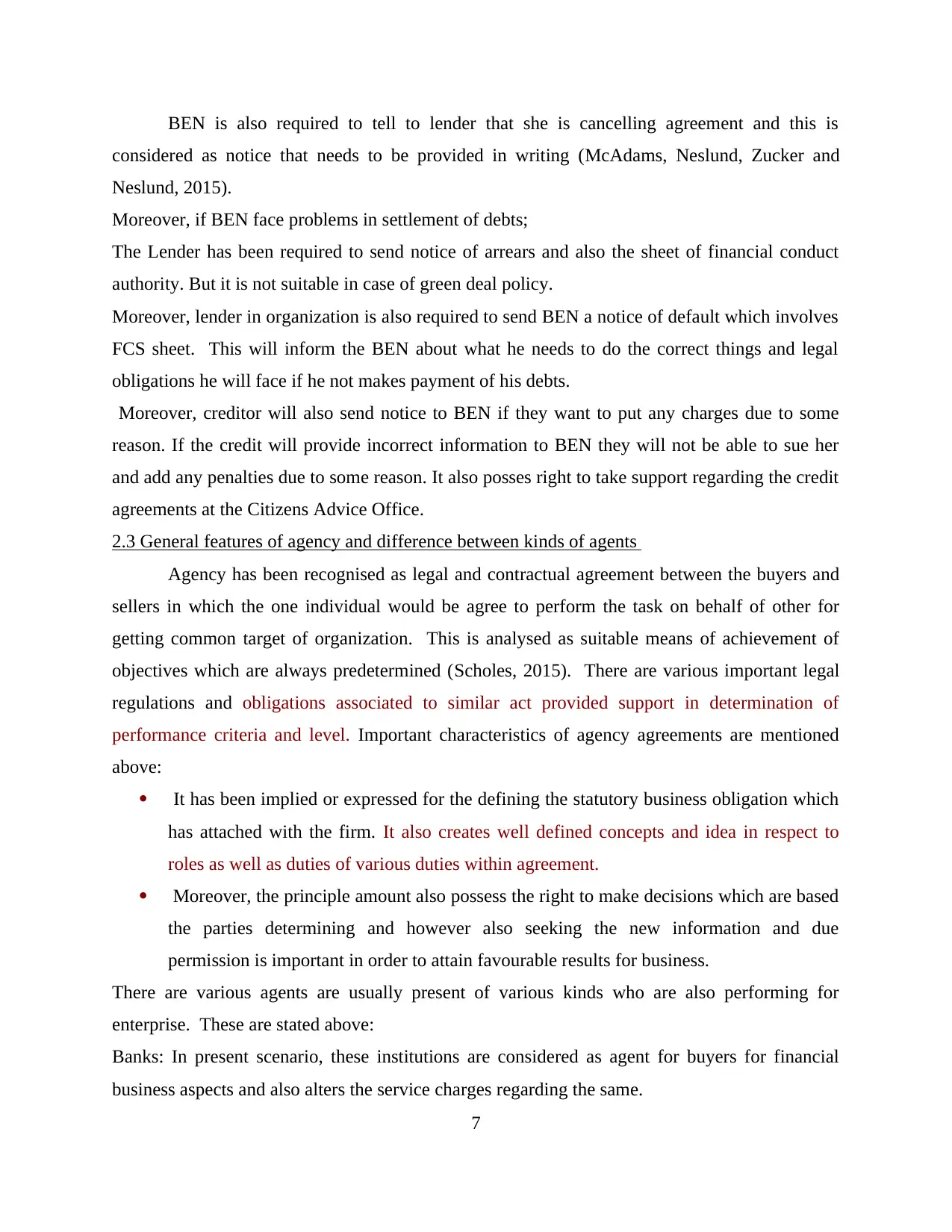
BEN is also required to tell to lender that she is cancelling agreement and this is
considered as notice that needs to be provided in writing (McAdams, Neslund, Zucker and
Neslund, 2015).
Moreover, if BEN face problems in settlement of debts;
The Lender has been required to send notice of arrears and also the sheet of financial conduct
authority. But it is not suitable in case of green deal policy.
Moreover, lender in organization is also required to send BEN a notice of default which involves
FCS sheet. This will inform the BEN about what he needs to do the correct things and legal
obligations he will face if he not makes payment of his debts.
Moreover, creditor will also send notice to BEN if they want to put any charges due to some
reason. If the credit will provide incorrect information to BEN they will not be able to sue her
and add any penalties due to some reason. It also posses right to take support regarding the credit
agreements at the Citizens Advice Office.
2.3 General features of agency and difference between kinds of agents
Agency has been recognised as legal and contractual agreement between the buyers and
sellers in which the one individual would be agree to perform the task on behalf of other for
getting common target of organization. This is analysed as suitable means of achievement of
objectives which are always predetermined (Scholes, 2015). There are various important legal
regulations and obligations associated to similar act provided support in determination of
performance criteria and level. Important characteristics of agency agreements are mentioned
above:
It has been implied or expressed for the defining the statutory business obligation which
has attached with the firm. It also creates well defined concepts and idea in respect to
roles as well as duties of various duties within agreement.
Moreover, the principle amount also possess the right to make decisions which are based
the parties determining and however also seeking the new information and due
permission is important in order to attain favourable results for business.
There are various agents are usually present of various kinds who are also performing for
enterprise. These are stated above:
Banks: In present scenario, these institutions are considered as agent for buyers for financial
business aspects and also alters the service charges regarding the same.
7
considered as notice that needs to be provided in writing (McAdams, Neslund, Zucker and
Neslund, 2015).
Moreover, if BEN face problems in settlement of debts;
The Lender has been required to send notice of arrears and also the sheet of financial conduct
authority. But it is not suitable in case of green deal policy.
Moreover, lender in organization is also required to send BEN a notice of default which involves
FCS sheet. This will inform the BEN about what he needs to do the correct things and legal
obligations he will face if he not makes payment of his debts.
Moreover, creditor will also send notice to BEN if they want to put any charges due to some
reason. If the credit will provide incorrect information to BEN they will not be able to sue her
and add any penalties due to some reason. It also posses right to take support regarding the credit
agreements at the Citizens Advice Office.
2.3 General features of agency and difference between kinds of agents
Agency has been recognised as legal and contractual agreement between the buyers and
sellers in which the one individual would be agree to perform the task on behalf of other for
getting common target of organization. This is analysed as suitable means of achievement of
objectives which are always predetermined (Scholes, 2015). There are various important legal
regulations and obligations associated to similar act provided support in determination of
performance criteria and level. Important characteristics of agency agreements are mentioned
above:
It has been implied or expressed for the defining the statutory business obligation which
has attached with the firm. It also creates well defined concepts and idea in respect to
roles as well as duties of various duties within agreement.
Moreover, the principle amount also possess the right to make decisions which are based
the parties determining and however also seeking the new information and due
permission is important in order to attain favourable results for business.
There are various agents are usually present of various kinds who are also performing for
enterprise. These are stated above:
Banks: In present scenario, these institutions are considered as agent for buyers for financial
business aspects and also alters the service charges regarding the same.
7
⊘ This is a preview!⊘
Do you want full access?
Subscribe today to unlock all pages.

Trusted by 1+ million students worldwide
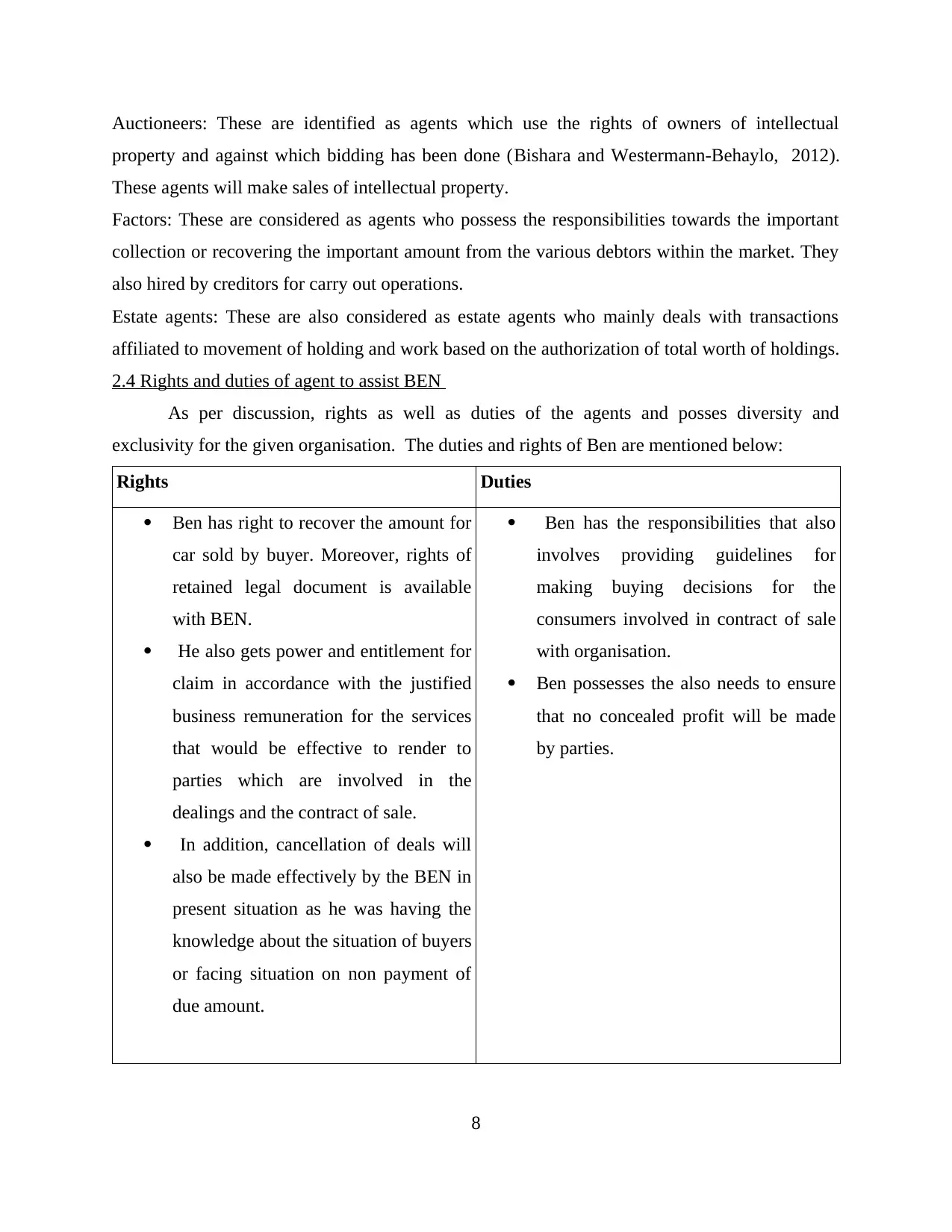
Auctioneers: These are identified as agents which use the rights of owners of intellectual
property and against which bidding has been done (Bishara and Westermann‐Behaylo, 2012).
These agents will make sales of intellectual property.
Factors: These are considered as agents who possess the responsibilities towards the important
collection or recovering the important amount from the various debtors within the market. They
also hired by creditors for carry out operations.
Estate agents: These are also considered as estate agents who mainly deals with transactions
affiliated to movement of holding and work based on the authorization of total worth of holdings.
2.4 Rights and duties of agent to assist BEN
As per discussion, rights as well as duties of the agents and posses diversity and
exclusivity for the given organisation. The duties and rights of Ben are mentioned below:
Rights Duties
Ben has right to recover the amount for
car sold by buyer. Moreover, rights of
retained legal document is available
with BEN.
He also gets power and entitlement for
claim in accordance with the justified
business remuneration for the services
that would be effective to render to
parties which are involved in the
dealings and the contract of sale.
In addition, cancellation of deals will
also be made effectively by the BEN in
present situation as he was having the
knowledge about the situation of buyers
or facing situation on non payment of
due amount.
Ben has the responsibilities that also
involves providing guidelines for
making buying decisions for the
consumers involved in contract of sale
with organisation.
Ben possesses the also needs to ensure
that no concealed profit will be made
by parties.
8
property and against which bidding has been done (Bishara and Westermann‐Behaylo, 2012).
These agents will make sales of intellectual property.
Factors: These are considered as agents who possess the responsibilities towards the important
collection or recovering the important amount from the various debtors within the market. They
also hired by creditors for carry out operations.
Estate agents: These are also considered as estate agents who mainly deals with transactions
affiliated to movement of holding and work based on the authorization of total worth of holdings.
2.4 Rights and duties of agent to assist BEN
As per discussion, rights as well as duties of the agents and posses diversity and
exclusivity for the given organisation. The duties and rights of Ben are mentioned below:
Rights Duties
Ben has right to recover the amount for
car sold by buyer. Moreover, rights of
retained legal document is available
with BEN.
He also gets power and entitlement for
claim in accordance with the justified
business remuneration for the services
that would be effective to render to
parties which are involved in the
dealings and the contract of sale.
In addition, cancellation of deals will
also be made effectively by the BEN in
present situation as he was having the
knowledge about the situation of buyers
or facing situation on non payment of
due amount.
Ben has the responsibilities that also
involves providing guidelines for
making buying decisions for the
consumers involved in contract of sale
with organisation.
Ben possesses the also needs to ensure
that no concealed profit will be made
by parties.
8
Paraphrase This Document
Need a fresh take? Get an instant paraphrase of this document with our AI Paraphraser
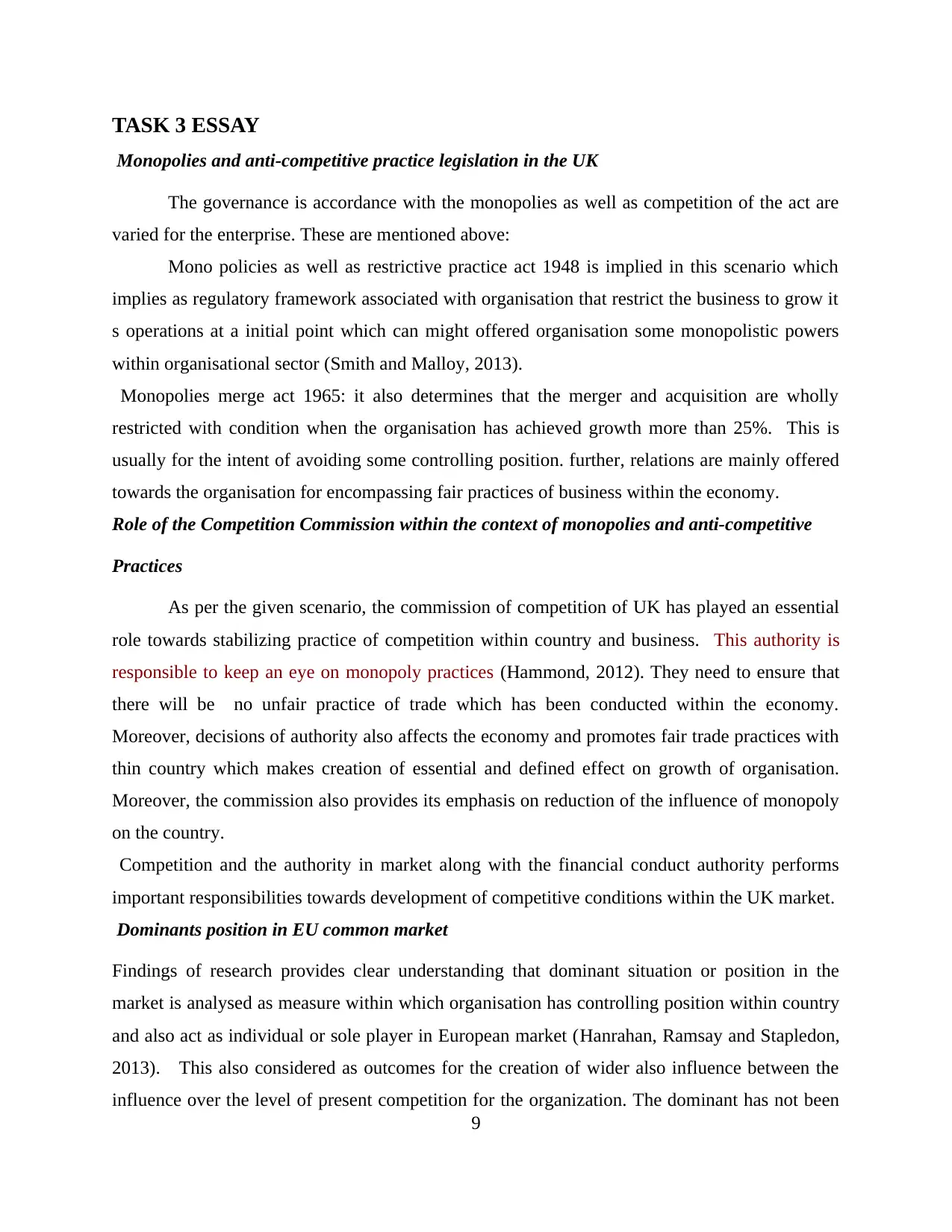
TASK 3 ESSAY
Monopolies and anti-competitive practice legislation in the UK
The governance is accordance with the monopolies as well as competition of the act are
varied for the enterprise. These are mentioned above:
Mono policies as well as restrictive practice act 1948 is implied in this scenario which
implies as regulatory framework associated with organisation that restrict the business to grow it
s operations at a initial point which can might offered organisation some monopolistic powers
within organisational sector (Smith and Malloy, 2013).
Monopolies merge act 1965: it also determines that the merger and acquisition are wholly
restricted with condition when the organisation has achieved growth more than 25%. This is
usually for the intent of avoiding some controlling position. further, relations are mainly offered
towards the organisation for encompassing fair practices of business within the economy.
Role of the Competition Commission within the context of monopolies and anti-competitive
Practices
As per the given scenario, the commission of competition of UK has played an essential
role towards stabilizing practice of competition within country and business. This authority is
responsible to keep an eye on monopoly practices (Hammond, 2012). They need to ensure that
there will be no unfair practice of trade which has been conducted within the economy.
Moreover, decisions of authority also affects the economy and promotes fair trade practices with
thin country which makes creation of essential and defined effect on growth of organisation.
Moreover, the commission also provides its emphasis on reduction of the influence of monopoly
on the country.
Competition and the authority in market along with the financial conduct authority performs
important responsibilities towards development of competitive conditions within the UK market.
Dominants position in EU common market
Findings of research provides clear understanding that dominant situation or position in the
market is analysed as measure within which organisation has controlling position within country
and also act as individual or sole player in European market (Hanrahan, Ramsay and Stapledon,
2013). This also considered as outcomes for the creation of wider also influence between the
influence over the level of present competition for the organization. The dominant has not been
9
Monopolies and anti-competitive practice legislation in the UK
The governance is accordance with the monopolies as well as competition of the act are
varied for the enterprise. These are mentioned above:
Mono policies as well as restrictive practice act 1948 is implied in this scenario which
implies as regulatory framework associated with organisation that restrict the business to grow it
s operations at a initial point which can might offered organisation some monopolistic powers
within organisational sector (Smith and Malloy, 2013).
Monopolies merge act 1965: it also determines that the merger and acquisition are wholly
restricted with condition when the organisation has achieved growth more than 25%. This is
usually for the intent of avoiding some controlling position. further, relations are mainly offered
towards the organisation for encompassing fair practices of business within the economy.
Role of the Competition Commission within the context of monopolies and anti-competitive
Practices
As per the given scenario, the commission of competition of UK has played an essential
role towards stabilizing practice of competition within country and business. This authority is
responsible to keep an eye on monopoly practices (Hammond, 2012). They need to ensure that
there will be no unfair practice of trade which has been conducted within the economy.
Moreover, decisions of authority also affects the economy and promotes fair trade practices with
thin country which makes creation of essential and defined effect on growth of organisation.
Moreover, the commission also provides its emphasis on reduction of the influence of monopoly
on the country.
Competition and the authority in market along with the financial conduct authority performs
important responsibilities towards development of competitive conditions within the UK market.
Dominants position in EU common market
Findings of research provides clear understanding that dominant situation or position in the
market is analysed as measure within which organisation has controlling position within country
and also act as individual or sole player in European market (Hanrahan, Ramsay and Stapledon,
2013). This also considered as outcomes for the creation of wider also influence between the
influence over the level of present competition for the organization. The dominant has not been
9
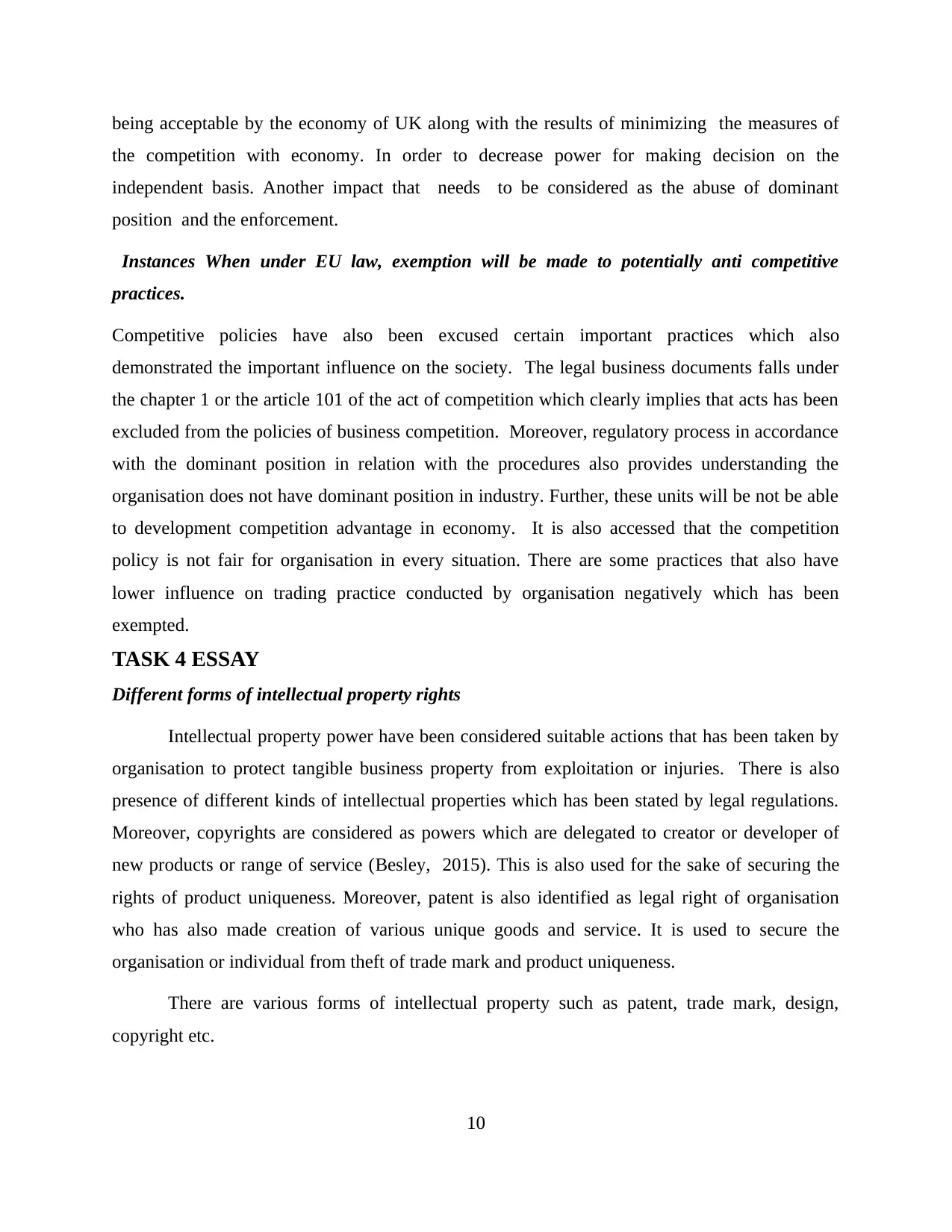
being acceptable by the economy of UK along with the results of minimizing the measures of
the competition with economy. In order to decrease power for making decision on the
independent basis. Another impact that needs to be considered as the abuse of dominant
position and the enforcement.
Instances When under EU law, exemption will be made to potentially anti competitive
practices.
Competitive policies have also been excused certain important practices which also
demonstrated the important influence on the society. The legal business documents falls under
the chapter 1 or the article 101 of the act of competition which clearly implies that acts has been
excluded from the policies of business competition. Moreover, regulatory process in accordance
with the dominant position in relation with the procedures also provides understanding the
organisation does not have dominant position in industry. Further, these units will be not be able
to development competition advantage in economy. It is also accessed that the competition
policy is not fair for organisation in every situation. There are some practices that also have
lower influence on trading practice conducted by organisation negatively which has been
exempted.
TASK 4 ESSAY
Different forms of intellectual property rights
Intellectual property power have been considered suitable actions that has been taken by
organisation to protect tangible business property from exploitation or injuries. There is also
presence of different kinds of intellectual properties which has been stated by legal regulations.
Moreover, copyrights are considered as powers which are delegated to creator or developer of
new products or range of service (Besley, 2015). This is also used for the sake of securing the
rights of product uniqueness. Moreover, patent is also identified as legal right of organisation
who has also made creation of various unique goods and service. It is used to secure the
organisation or individual from theft of trade mark and product uniqueness.
There are various forms of intellectual property such as patent, trade mark, design,
copyright etc.
10
the competition with economy. In order to decrease power for making decision on the
independent basis. Another impact that needs to be considered as the abuse of dominant
position and the enforcement.
Instances When under EU law, exemption will be made to potentially anti competitive
practices.
Competitive policies have also been excused certain important practices which also
demonstrated the important influence on the society. The legal business documents falls under
the chapter 1 or the article 101 of the act of competition which clearly implies that acts has been
excluded from the policies of business competition. Moreover, regulatory process in accordance
with the dominant position in relation with the procedures also provides understanding the
organisation does not have dominant position in industry. Further, these units will be not be able
to development competition advantage in economy. It is also accessed that the competition
policy is not fair for organisation in every situation. There are some practices that also have
lower influence on trading practice conducted by organisation negatively which has been
exempted.
TASK 4 ESSAY
Different forms of intellectual property rights
Intellectual property power have been considered suitable actions that has been taken by
organisation to protect tangible business property from exploitation or injuries. There is also
presence of different kinds of intellectual properties which has been stated by legal regulations.
Moreover, copyrights are considered as powers which are delegated to creator or developer of
new products or range of service (Besley, 2015). This is also used for the sake of securing the
rights of product uniqueness. Moreover, patent is also identified as legal right of organisation
who has also made creation of various unique goods and service. It is used to secure the
organisation or individual from theft of trade mark and product uniqueness.
There are various forms of intellectual property such as patent, trade mark, design,
copyright etc.
10
⊘ This is a preview!⊘
Do you want full access?
Subscribe today to unlock all pages.

Trusted by 1+ million students worldwide
1 out of 16
Related Documents
Your All-in-One AI-Powered Toolkit for Academic Success.
+13062052269
info@desklib.com
Available 24*7 on WhatsApp / Email
![[object Object]](/_next/static/media/star-bottom.7253800d.svg)
Unlock your academic potential
Copyright © 2020–2025 A2Z Services. All Rights Reserved. Developed and managed by ZUCOL.





